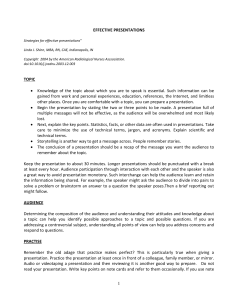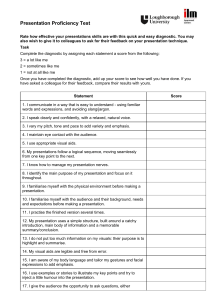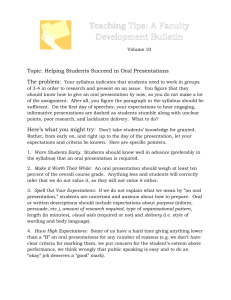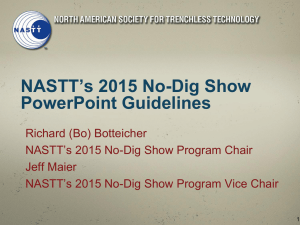Writing for Your Readers
advertisement
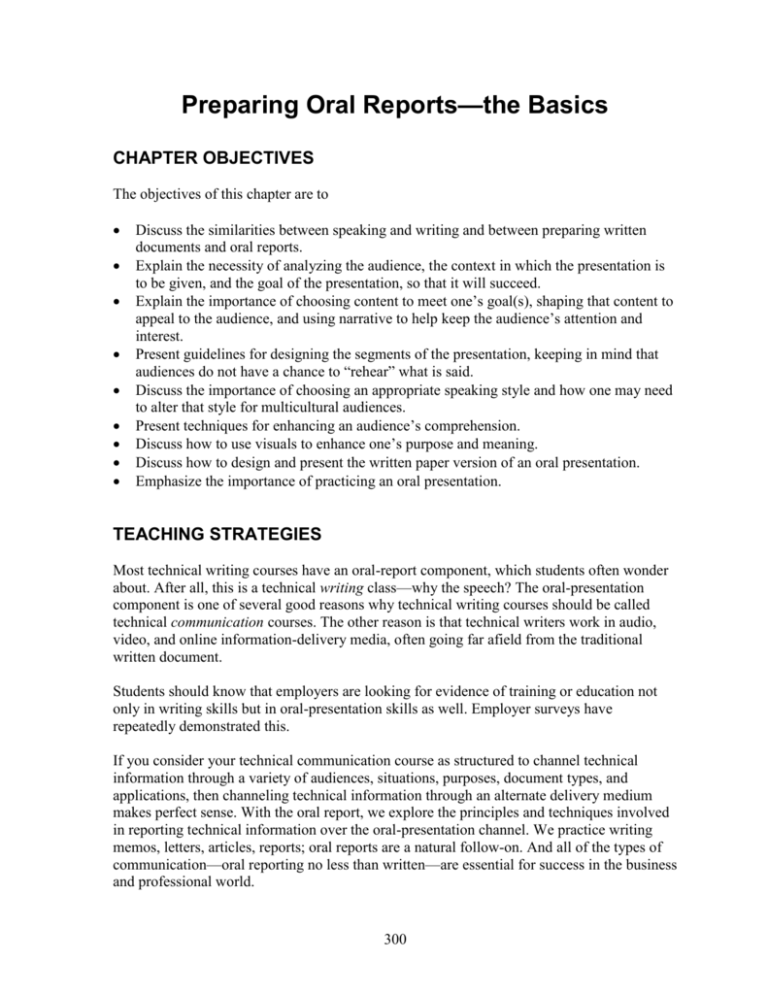
Preparing Oral Reports—the Basics CHAPTER OBJECTIVES The objectives of this chapter are to Discuss the similarities between speaking and writing and between preparing written documents and oral reports. Explain the necessity of analyzing the audience, the context in which the presentation is to be given, and the goal of the presentation, so that it will succeed. Explain the importance of choosing content to meet one’s goal(s), shaping that content to appeal to the audience, and using narrative to help keep the audience’s attention and interest. Present guidelines for designing the segments of the presentation, keeping in mind that audiences do not have a chance to “rehear” what is said. Discuss the importance of choosing an appropriate speaking style and how one may need to alter that style for multicultural audiences. Present techniques for enhancing an audience’s comprehension. Discuss how to use visuals to enhance one’s purpose and meaning. Discuss how to design and present the written paper version of an oral presentation. Emphasize the importance of practicing an oral presentation. TEACHING STRATEGIES Most technical writing courses have an oral-report component, which students often wonder about. After all, this is a technical writing class—why the speech? The oral-presentation component is one of several good reasons why technical writing courses should be called technical communication courses. The other reason is that technical writers work in audio, video, and online information-delivery media, often going far afield from the traditional written document. Students should know that employers are looking for evidence of training or education not only in writing skills but in oral-presentation skills as well. Employer surveys have repeatedly demonstrated this. If you consider your technical communication course as structured to channel technical information through a variety of audiences, situations, purposes, document types, and applications, then channeling technical information through an alternate delivery medium makes perfect sense. With the oral report, we explore the principles and techniques involved in reporting technical information over the oral-presentation channel. We practice writing memos, letters, articles, reports; oral reports are a natural follow-on. And all of the types of communication—oral reporting no less than written—are essential for success in the business and professional world. 300 This chapter has significantly changed from the previous edition. The new version shifts the discussion from primarily focusing on the oral report itself (how it should be organized, what it should look like, and how it should be presented) to focusing on the considerations that should shape it: audience, context, and purpose. It then discusses how the oral report should be designed in response to these considerations. The updated chapter also contextualizes the oral report within technical communication as a whole by discussing its relationship to written documents, thus giving students a broader understanding of communication in the professional world. As for the timing of the oral report during the semester, you can use it as a change of pace from intense written projects or as a lighter assignment at the end of the semester when your students are completing their final reports. WORKSHOP ACTIVITIES Here are some ideas for in-class activities to help students learn about oral reports. Traditional Classroom 1. Bring taped five- to eight-minute oral presentations to class. See if you can get some audio or video recordings of oral reports. School board and city council sessions, which are often shown on local cable channels, may be a good source. Consider taping your own classes and building a library of oral presentations. When you play these tapes, ask students to listen especially carefully for the use of narrative, for the key elements of the introduction, for effective use of repetition in the body of the report, for effective conclusions and use of visuals, and for other considerations discussed in this chapter. Consider having students fill out an evaluation form for each taped oral report they hear. 2. Discuss giving an oral presentation of a written report. For a group-brainstorming session, select one of the short reports in the book, from the Companion Web Site (www.oup.com/us/houp), or from your own collection for re-presentation as an oral report. In the in-class planning session, apply the principles and techniques discussed in this chapter. 3. Discuss the Gettysburg PowerPoint Presentation. The Gettysburg PowerPoint Presentation Web site (http://www.norvig.com/Gettysburg/) is a marvelous spoof of oral reports! It takes one of the most famous and arguably best speeches of all time and creates a PowerPoint version of the speech that one might see/hear in a modern business/political setting. The spoof is great fun because the slides follow all of the guidelines we teach for good oral reports, yet they are clearly inferior to the original text (which is reproduced in the speaker notes). You may need to give a little history lesson to your classes, and whether you show—or read—the original speech before or after the presentation, is up to you. Your students should readily see the humor of the presentation; ask them why it is funny. This can be a great way to discuss the limitations of technology. A PowerPoint 301 presentation is hardly appropriate in such a context—imagine if President Bush had given such a presentation as he stood on the rubble of the World Trade Center. Also, the standard guidelines for oral reports utterly fail in this context—again, imagine President Bush giving an introduction/3 main points/conclusion presentation on that September day. Allow your students to explore the impact of audience, context, and purpose of an oral report and to consider in what contexts the standard guidelines just don’t apply. Computer Classroom 1. Experiment with creating a short PowerPoint presentation, and compare the results with a more traditional overhead projector approach. One of the traps many speakers, both students and professionals, fall into is the use of distractingly fancy multimedia presentations to support a speech (refer to Activity 3 above). The fireworks on the computer screen end up being a distraction from rather than a complement to the important part—what the speaker has to say. Divide students into small teams, and have some use a plain word processor to create three speech overheads on a pre-determined topic while others use fancier media to create the same. Then have them take turns presenting in front of the class and critiquing each other’s work in terms of effectiveness and ease of use. 2. Using a chat room or discussion board, anonymously discuss oral-report experiences, public speaking fears, etc. Students may alleviate some of their fears, at least in your course, by expressing them and seeing that we all generally share the same discomforts when addressing an audience. They may also have pointers to offer each other. Small groups, of no more than four, will work best here. Make sure to draw the end of the discussion back to the chapter or the assignment in order to make it most practical. You can even require students to summarize their chat session and to share that summary with the class, emphasizing conclusions and future applications. 3. Find a streaming video oral presentation online and critique it. The proliferation of Web sites with multimedia components has made this a relatively easy assignment to complete. Most major news organizations have front-page access to audio and video files. Let students use the oral-presentation rubric and act as an instructor reviewing a product. This may offer valuable lessons in what to do and not to do. Such critiques may be oral, short informal reports (via e-mail, for example), or lengthier and more formal reports— this choice is up to you. ORAL PROJECTS Many of the chapters in this instructor’s manual suggest possibilities for oral reports. Schedule the oral report according to your sense of how your technical writing class is progressing, when students need a change of pace, or when they need some relief from intense written projects. Here are some ideas for oral-report projects. 302 Traditional Assignments 1. Give an oral presentation of the final report. A common place in the semester for the oral report is during that time when students are working on their final reports. Have them present highlights or an overview of their written reports (which will still be in draft stage). They shouldn’t have to gather any information to do this assignment. 2. Give an oral presentation of the progress report. Consider having your students give an oral presentation of their progress reports. Their progress report can be strictly oral or it can be both oral and written. Doing so will give everybody a chance to compare notes and vent a little and give you, the instructor, a chance to help or clarify things. 3. Re-present a short written document orally. Have your students select a written report or article to re-present orally—one that they have themselves written earlier in the semester, one they select from some published source, or one that you supply out of your files. Having students select from published sources can make for a lively oral-reports week if you can trust your students to pick interesting technical reports or articles in their fields. Challenge them to present the technical information in their articles in a way that educated but nonspecialist listeners can understand. You can bill the whole unit as a collegewide conference entitled “What’s Hot in Science and Technology”—and charge an admission fee! 4. Present a product or process idea to senior management. As suggested by Exercise 1 in the textbook, you can have your students assume they are head of a development team that is attempting to sell management on a new-product idea. Or they can assume they are attempting to convince management to buy a new technology or adopt a new process. Distance Learning Assignments 1. Draft a short speech along with complementary, coordinated presentation overheads. Even in a distance class, students can get a feel for the preparation of oral presentations by drafting the speech and the overheads. They simply indicate where in the speech each visual should appear. Make sure to indicate a time constraint and possibly technology constraints for this project. In the near future, students may actually be able to complete the presentation using webcams. 2. Attend any live presentation; then report on the techniques used and critique the speaker. Much like the streaming audio/video exercise, this will simply give the student a heightened perspective of what being in the audience’s shoes is like. Encourage students to share plans about who, what, and when they’ll attend. If time and geography permit, seeing a comparison of interpretations would be fun and could offer interesting insight into how different audience members, even with similar purposes, may react differently to the same speaker. 3. Find a streaming video oral presentation online and critique it. This is the same as computer classroom Activity 3 above. See it for more detail. 303 RELEVANT LINKS Some Tips for Making Effective Presentations (http://www.siam.org/meetings/tips.htm) LJL Seminars: Using Visual Aids as Notes (http://www.ljlseminars.com/visuals.htm) Rice Owl Online Writing Lab: Designing Effective Oral Presentations (http://www.ruf.rice.edu/~riceowl/oralpres.html) Jeff Radel, University of Kansas Medical Center: Preparing Effective Oral Presentations (http://www.kumc.edu/SAH/OTEd/jradel/Preparing_talks/TalkStrt.html) Ethel M. Cook on Business Know-how.com: Making Business Presentations Work (http://www.businessknowhow.com/manage/presentation101.htm) David Birdsell: Presentation Graphics (http://www.mhhe.com/socscience/comm/lucas/student/birdsell/birdsell1.htm) Support4Learning: Interviews and Presentations (http://www.support4learning.org.uk/jobsearch/interviews.htm) WORKSHEETS You may wish to reproduce the following worksheets for use in class or as homework. 304 Evaluating Visual Aid Types Type of Aid Pros Cons Graphs Tables Representation art (i.e., line drawings) Photographs Words & phrases Cartoons Hardware Think in terms of audience needs, expectations. Think in terms of visual aid design and presentation tool. 305 Evaluating Visual Presentation Tools Type of Tool Pros Cons Computer Overhead projector Slides Charts Movies/videos Chalkboards Other Think in terms of trouble-shooting in case your planned tool doesn’t work. 306 Oral Report—Sample Assignment 1 After you’ve studied the oral-reports unit in the textbook, prepare an oral report of your own, using the guidelines discussed below: Prepare a script for a seven-minute oral report to present in person to the class on some aspect of the topic on which you are writing your technical report. Do not try to summarize your report—just hit the highlights, the interesting or key points, and direct listeners to the written report. Give them a sense of what the report covers, but don’t try to provide all the details. Identify a realistic audience, purpose, and situation for your oral report, and explain this briefly before your talk. (This explanation does not count as part of the seven minutes and should not last more than one minute.) Find a reliable way to rehearse your presentation, preferably by recording and listening to yourself. Find a reliable way to refer to your notes or outline. Avoid heads-down reading off a script. No points off for nervousness! Use at least one visual in your presentation; plan to discuss it in your talk. (Your instructor can help you prepare transparencies.) Standards of clarity, appropriateness to audience, grammar, usage, punctuation, and spelling apply to these visuals just as they do to your other written work. Work on the substance and clarity of your technical discussion: make sure you present detailed information and that your explanations of technical aspects of the report are understandable to nonspecialists. Plan your introduction and conclusion carefully. Include a purpose statement and overview in your introduction; attempt to gain some interest. Don’t just trail off into a mumble at the end. Use verbal headings during the oral report to signal listeners when you are moving from one section of your talk to the next. Make sure your presentation is well organized and doesn’t seem to ramble. Make sure your presentation style is clear, audible, and understandable and that gestures and posture are under control. As you listen to other students’ oral reports, evaluate them using a special form that will be handed out (You get a letter grade added to your oral report grade for listening to and evaluating all the other oral reports.). 307 Oral Report—Sample Assignment 2 Read the chapter in Reporting Technical Information on oral reports; then prepare a speech that will be a well-organized, well-prepared, and carefully delivered presentation on a serious, informative topic of your choice. Your speech should be no shorter than four minutes and no longer than seven minutes. Put your name and the title of your speech on the board before the beginning of your speech. Other visuals can highlight key words, diagrams, and other aspects of your speech; but be sure to refer to your visuals as you give your speech. For diagrams, use overhead transparencies, drawings, or posters. You may use notes as you deliver your speech. Avoid reading a written manuscript. Speeches read from manuscripts will not be acceptable. Your speech will be judged by these criteria: Its delivery time is between four and seven minutes. The speech is well prepared and well organized. The speaker performs but does not read the text. The speaker’s delivery is clear and audible. The speech has a careful introduction to its topic and purpose and a careful summary and conclusion at its end. Careful preparation and practice at home will increase your chances of an excellent grade. Helpful things to do: Use overhead projections or PowerPoint slides and illustrations if they will make your topic clearer. Refer to illustrations when you discuss them. Use your notes as reminders, not as something to read. Things not do to: Never turn your back on an audience. Never draw on the board during a speech. (Prepare your visuals ahead of time.) Never try to speak on a topic you have not prepared carefully. Class members will evaluate speeches on a special evaluation form. Each speaker will receive all of the forms about her or his speech. Be close observers and specific but tactful critics. Your comments will help speakers improve on future speech performances. When you listen to the speech presentations, listen for the following: Content. A good speech must have a well-defined and limited topic, a stated purpose, and clear development. The focus of the presentation should be the topic of the speech, not the 308 personality, wit, or role of the speaker. Remember, a good speaker always puts the audience’s understanding of the topic first. Organization. Good speeches stress organization. It’s much harder to follow a speech than a piece of written communication. As a result, carefully drawn introductions and closings, transitions, and brief reviews are especially helpful for listeners. Performance. An effective public speaker talks to an audience, not at an audience. Look for eye contact; a steady, slow pace of speaking; an audible, relaxed voice; and the ability to avoid nervous mannerisms, awkward gestures, and an unsteady posture. Speakers should never turn their backs on audiences during speech presentations. Visual Aids. Large, easy-to-read visual aids and well-planned demonstrations can make a speech much more interesting and understandable to an audience. 309 Evaluation Form: Oral Reports Name Topic/Title Date Interesting Title 1 2 3 4 5 1 1 1 2 2 2 3 3 3 4 4 4 5 5 5 1 1 1 2 2 2 3 3 3 4 4 4 5 5 5 1 1 1 2 2 2 3 3 3 4 4 4 5 5 5 1 1 1 2 2 2 3 3 3 4 4 4 5 5 5 1 2 3 4 5 Introduction Connects with the audience; builds interest. States topic and purpose. States main points that will be covered. Body and Conclusion Clearly demarcates and announces each point. Covers a reasonable number of points. Conclusion reinforces the main points or perspective of the report. Delivery Speaking style (volume, pitch, rate) is effective. Movement and gestures are effective. Has characteristics of conversation rather than written speech. Visual Aids Provide effective support and focus. Are visible, clear, simple, and controlled. Are introduced and discussed. Presentation Tools Make effective use of overhead projector, flip charts, chalkboard, charts, slides, movies or videos, computer technology (circle one or more). Rate each element, with 1 being completely ineffective and 5 being excellent. 310 OVERHEADS The figures on the following pages may be reproduced as overhead transparencies or simply shown on a computer. The following set of discussion questions associated with each of the figures may be used to elicit student reflections on the concepts. Discussion Questions for Figure 19-1 How might each of the elements listed here differ between written documents and oral reports? How might audiences differ? The context? Have you ever had to write a document, such as a report, and then give an oral report on that document? How did you adapt the written document for the presentation? Discussion Questions for Figure 19-2 Have you ever sat through a presentation that failed to keep your attention or to meet your needs as an audience? How might the presentation have been improved if the speaker had analyzed his/her context this way? How/why do you think considering each of these things can be vital to the success of a presentation? Can you imagine situations in which failure to consider one/some of these might be disastrous for the outcome of the speech? Discussion Questions for Figures 19-3 through 19-5 Quite often when planning presentations, student speakers only consider the content of the presentation, ignoring the planning stages described in these figures. What are the weaknesses that you often see in your peers’—and your—presentations? How might considering the things discussed in these figures help correct those problems? Which of these things have you considered before when planning presentations? Which are new considerations for you? Which do you think will be most valuable to you as a speaker? Consider these guidelines in light of a multicultural or ESL audience; which of the guidelines do you think will be most crucial to consider in order to ensure a successful presentation for that audience? Discussion Questions for Figure 19-6 Visuals can be a challenge in a presentation; what visuals have you used or seen used that you especially appreciated? Why? What visuals have you used or seen used that were especially ineffective? Why? What is your biggest challenge in terms of choosing/designing visuals for presentations? 311 Discussion Questions for Figures 19-7 & 19-8 Have you ever heard a presentation read as described here? Why was it read? Was it effective for the context? How did you respond to it? Have you ever written a speech that would have to be read? How might the guidelines in Figure 19-8 have helped you? Discussion Questions for Figure 19-9 Do you practice presentations before you give them? Why or why not? How might practicing your presentation help you improve it? Have you ever sat through a presentation that was clearly not practiced? What were the problems? How did you react to it? 312 Requirements of Writers/Presenters Analyze your audience Understand the context in which the presentation will be received Understand and articulate your purpose clearly Develop sufficient and appropriate supporting material Organize and arrange content so that it is easy for the audience to follow Choose a speaking style suitable to your role as well as to your audience or purpose Select the presentation format and visuals that will enhance your audience’s understanding of your message Figure 19-1: Requirements of Writers/Presenters Analyzing the Context for an Oral Report What is the broader concern underlying the need for the presentation? What primary issues underlie the presentation? How does your presentation relate to these issues? What will be happening in the organization when you make your presentation? How does your presentation fit into the organizational situation? If you are one of several speakers, what kinds of presentations will the other speakers be making? In what surroundings will you be making the presentation? If your report contains confidential or proprietary information, what can you include in your actual presentation that will not compromise the integrity of the information? Figure 19-2: Analyzing the Context for an Oral Report Designing Oral Report Segments Choose an interesting title Develop the presentation around three main divisions: Introduction: Tell them what you are going to tell them Body: Tell them Conclusion: Tell them what you told them Plan the introduction carefully; it should: State the topic, the purpose, and the main points Catch the audience’s attention Provide any necessary background Motivate your audience to listen to you Establish your credibility, if necessary Design the body to help readers comprehend your ideas Design the conclusion to reinforce your main ideas Figure 19-3: Designing Oral Report Segments Choosing an Appropriate Speaking Style 1. When planning your presentation, ask the following questions about your relationship with your audience: Does the audience know you? Is your rank in the organization above or below them? Are you speaking to an audience of individuals from all levels within the organization? What demeanor, approach, and level of formality does the organization usually expect from those giving oral presentations? Is the audience composed of people who understand English? How well do they understand English? 2. When giving the presentation and the audience is uncomfortable with English, do the following: Speak slowly Avoid idiomatic language Choose concrete words Speak in relatively short sentences Figure 19-4: Choosing an Appropriate Speaking Style 3. When giving the presentation and the audience is an international or multicultural one, do the following: Do research to understand how people from other cultures are likely to interpret what you say, how you say it, how you dress, and how you act in your dealings with them Change graphics and visuals as necessary, especially to use symbols appropriately 4. When giving the presentation for any audience, do the following: Avoid long, cumbersome sentences Avoid overuse of abstract, polysyllabic words Avoid overuse of jargon, unless you are sure that the audience is familiar with specialized terms Use sentences that follow natural speech patterns Figure 19-4: Choosing an Appropriate Speaking Style Techniques to Enhance Audience Comprehension 1. Clearly demarcate the beginning and end of each point and segment of your presentation 2. Speak slowly and enthusiastically 3. Use gestures to accentuate points 4. Maintain eye contact with the audience 5. Do not memorize the presentation, and do not write your presentation 6. Rehearse your presentation until you are comfortable 7. If possible, record your speech 8. Listen for tone, attitude, and clarity 9. If you develop a PowerPoint presentation, use a notes format and distribute these before you begin the presentation Figure 19-5: Techniques to Enhance Audience Comprehension 10.Make your slides clear but simple 11.Determine how you will handle questions 12.Prepare for questions your audience may ask, and determine how you will answer each one 13.Keep the question and answer time moving briskly Figure 19-5: Techniques to Enhance Audience Comprehension Planning Visuals to Enhance Purpose and Meaning Avoid too much information on any single slide Use a font size that can be easily read Use sans serif font Limit the fonts to two per visual Avoid all caps If possible, provide a copy of your slides with an area for notes Avoid visuals that are too busy or complex Do not talk and present a slide at the same time Avoid talking too fast and showing too many slides Figure 19-6: Planning Visuals to Enhance Purpose and Meaning Reasons for Reading Presentations A presentation that discusses company policy, a sensitive issue, or a topic that must be approved by someone in the organization before the presentation is carefully written and read from the approved, written manuscript to ensure accuracy A presentation that will be circulated or filed as documentation may be read by a spokesperson, especially if there is a possibility that the material may be misused by the audience Inexperienced speakers who must deal with a difficult problem may be more comfortable reading from a prepared manuscript Figure 19-7: Reasons for Reading Presentations Writing the Speech 1. Be sure that each section is clearly demarcated from other sections 2. Limit each section and each paragraph within it to one idea 3. Avoid excessive detail 4. Use enumeration to help your audience follow your main points and to know when one point has ended and the next point is beginning 5. Avoid long sentences 6. Prune every sentence to make it as concise as possible 7. Use active voice whenever possible 8. Type your presentation in a large type 9. With a marker, draw break lines 10. Underline or highlight important phrases and ideas 11. Consider using visual aids Figure 19-8: Writing the Speech Practicing the Presentation 1. Read each sentence aloud; rewrite those that are difficult for you to say 2. Try to look directly at your audience and to speak important phrases or sentences directly to the audience 3. Use overviews and topic sentences to announce each major topic, and accompany these with pauses and looks to the audience 4. Recast sentences and paragraphs that do not sound organized, logical, and clear 5. Speak slowly and enunciate clearly and distinctly 6. Time the presentation to be sure that it fits within the time limit 7. Read the speech into a recorder Figure 19-9: Practicing the Presentation
